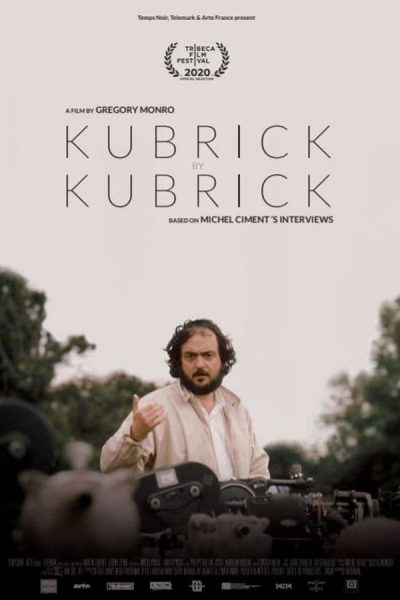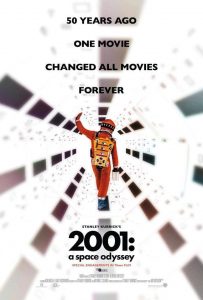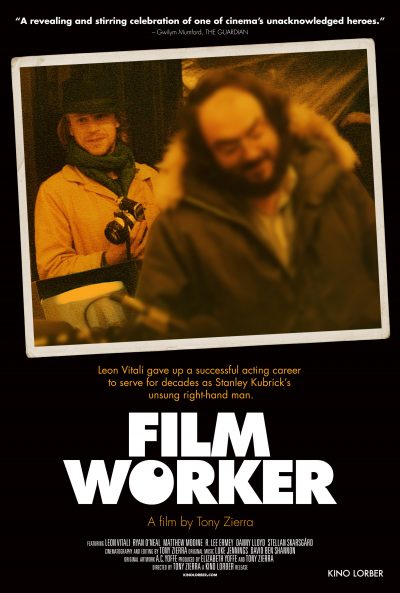“Kubrick by Kubrick” (2020). Cast: Archive Footage/Recordings: Stanley Kubrick, Michel Ciment, Jack Nicholson, Peter Sellers, Tom Cruise, Nicole Kidman, Sterling Hayden, Malcolm McDowell, Shelley Duvall, R. Lee Ermey, Vincent D’Onofrio, Marisa Berenson, Arthur C. Clarke, Ken Adam, Garrett Brown, Christiane Kubrick, Roger Ebert. Director: Gregory Munro. Screenplay: Gregory Munro. Web site. Trailer.
True geniuses in cinema are indeed rare, despite the tremendous inflationary hype that has occurred in bestowing such an esteemed degree of recognition in recent years. It’s a title that should be reserved for those who have brought their brilliance to the art and advanced it in ways that had not been previously dared or even envisioned. These filmmakers are the groundbreakers, the audacious artists who have opened doors not only for themselves, but also for those who succeeded them. And, in doing so, they have taken moviemaking to an entirely new level, as profiled in the excellent new documentary, “Kubrick by Kubrick.”

Few will disagree that one of the giants among these inspired innovators was director Stanley Kubrick (1928-1999). The New York native who spent much of his professional life in England wasn’t one of the industry’s most prolific filmmakers, often spending years between projects, but his output is some of the most memorable and inventive in movie history. And Kubrick’s work provided the inspiration for many who followed, influencing the development of others who later would go on to their own greatness, such as Steven Spielberg.
Because Kubrick’s innovations were so cutting edge, his work wasn’t always understood or appreciated to the degree it deserved to be at the time of its release. The auteur’s tendency to be something of an enigmatic recluse added to that mystique. He seldom granted interviews and engaged only minimally in publicity efforts for his productions. Yet, despite his unconventional ways of working, his films were nearly always awaited with eager anticipation, with moviegoers anxiously curious to find out what he would come up with next. As a result, Kubrick became an atypically charismatic figure, one who developed a loyal, almost cult-like following, one that has only grown in the years since his passing.
Even though Kubrick was largely withdrawn when it came to his dealings with reviewers and journalists, he nevertheless established an ongoing relationship with French writer-editor Michel Ciment, who wrote a major overview of the director’s repertoire in 1968. Kubrick subsequently contacted Ciment, and thus began a 20-year dialogue between the two. Through a series of audio interviews, Kubrick opened up about his art, offering insights into his method, his outlooks and how his projects came together.
The contents of those interviews form the basis of director Gregory Munro’s documentary. Through numerous sound bites from Ciment’s recordings, Kubrick comes back to life for viewers. He speaks extensively about cinema theory, as well as his individual film projects in an array of aspects, from casting to thematic elements to filming techniques. It’s a revelatory experience to be sure.
The audio segments are augmented with a wealth of clips from most of Kubrick’s films, including “Paths of Glory” (1957), “Spartacus” (1960), “Dr. Strangelove” (1964), “2001: A Space Odyssey” (1968), “A Clockwork Orange” (1971), “Barry Lyndon” (1975), “The Shining” (1980), “Full Metal Jacket” (1987) and “Eyes Wide Shut” (1999). It also includes incisive archival interview footage with those who worked with him, including actors Jack Nicholson, Peter Sellers, Tom Cruise, Nicole Kidman, Sterling Hayden, Malcolm McDowell, Shelley Duvall, Vincent D’Onofrio, Marisa Berenson and R. Lee Ermey, as well as collaborators like writer Arthur C. Clarke, production designer Ken Adam and cameraman Garrett Brown, noted film critic Roger Ebert, and Kubrick’s wife of 41 years, Christiane.
“Kubrick by Kubrick” reinforces some of the signature elements characteristic of the director’s offerings, such as the look of impersonal yet captivating detachment often present in the camera work of many of his pictures. It also addresses Kubrick’s meticulousness for perfection, particularly how virtually all aspects of his works were deliberately constructed down to the smallest detail. Yet, surprisingly, the film also reveals Kubrick’s appreciation for improvisation (especially from his cast members) and his willingness to incorporate such inventiveness into his finished products when he believed it enhanced the production, a quality unexpected from someone who had a reputation for being one of the industry’s most notorious control freaks. Examples include Malcolm McDowell’s macabre rendition of Singin’ in the Rain in “A Clockwork Orange” and Peter Sellers’s comically uncontrollable Nazi salute in “Dr. Strangelove.” Kubrick indeed recognized cinematic pots of gold when he saw them and never shied away from making use of them when appropriate.

Kubrick’s films are known for their stellar acting, but those portrayals often came about by way of unconventional means. The director employed some unusual (some would even say merciless) techniques to coax his cast members into delivering performances that he knew they were capable of giving, even if they didn’t. In recounting their experiences in working on “The Shining” and “Dr. Strangelove,” Shelley Duvall and Sterling Hayden, respectively, spoke of how Kubrick had them perform some scenes so many times that they were on the verge of losing it, coming to believe that the filmmaker was a sadistic tyrant incapable of being satisfied. Yet it was in those later takes that Kubrick would usually find what he was looking for out of them. The release of raw emotions that he wanted would finally surface, but it never would have happened until he drew it out of them through such debilitatingly exhausting practices.
Those who knew and worked with Kubrick acknowledged that he was often drawn to the darker elements of existence, and directorial tactics like those just described would seem to suggest that his captivation with life’s menacing aspects was even capable of surfacing through him and his behavior to a somewhat questionable degree. But, at the same time, Kubrick’s sidelong cynical outlook and its depiction through his work is what made his films so compelling – and memorable. Without a doubt, Kubrick frequently dealt with ominous and troubling subject matter, but, in doing so, he put a spotlight on it, exposing it for what it was and pushing us to recognize the warnings he was imparting in these important cautionary tales. In his own way, it was as if he was asking us how willing we are to tolerate atrocities like the hell of war so vividly captured in “Full Metal Jacket” or the decadent, intrusive, intimidating invasiveness of the power elite depicted in “Eyes Wide Shut” or the potential dangers of artificial intelligence chillingly chronicled in “2001: A Space Odyssey,” all of them serving as quiet but powerful calls to arms.
Just as Kubrick worked to move the art of cinema forward, his films thus encourage us to move forward personally, both individually and collectively, even if that message is delivered in a somewhat backhanded way. The question is, will we rise to the challenge? It probably depends on how closely we’re watching – and how well we’re paying attention. Maybe we need the kind of eye-opening inventiveness that characterizes Kubrick’s work to get the message.
Given the themes of Kubrick’s films, many moviegoers have developed the impression that the director was a pained artist, one who harbored a tortured soul. But, considering the brilliance of his work, he was a profound thinker. It’s also apparent that he saw his pictures as labors of love, vehicles for expressing the love of creativity for its own sake, a celebration of the joy and power inherent in it. It’s a principle at the very heart of conscious creation, the philosophy that maintains we draw upon the inner resources of our thoughts, beliefs and intents to manifest the reality around us. And, when we look at what Kubrick accomplished, he truly was a master of its concepts, even if he had never heard of or studied this empowering and imaginatively fertile doctrine.
Kubrick certainly made the most of this philosophy and practice in his work. In groundbreaking films like “2001: A Space Odyssey”, the director pushed the limits of creativity, giving us an epic that broke all the rules, a gesture that was a lasting gift to cinephiles and generations of moviemakers to come. More than 50 years after its release, this cinematic milestone has held up tremendously, having set new standards in camera work, special effects, soundtrack scoring and narrative content, a story so rich and sublime that it continues to prompt profound discussion even today. But, then, that should come as no surprise when one embraces what conscious creation has to offer.

In employing this philosophy in his work, Kubrick drew upon a number of its key concepts. For example, despite the deliberate construction of his films, Kubrick engaged his intuition often. While intuitiveness may seem a somewhat intangible resource to employ in a definitive context, his use of it often produced cinematic gems. His willingness to draw upon improvisation and his unconventional practices for prompting cast members to dig deep within themselves to yield their best work typify his intuition at work. He may not have been able to quantify the value of this resource, but he trusted it, believing in its veracity and its ability to give him exactly what he needed when he needed it.
His penchant for pushing the envelope also reflected conscious creation at work. His inspired vision “enlarged” the art of filmmaking and, in so doing, expanded our consciousness about what is possible cinematically. This is true both for those who make and watch films, raising our expectations and the state of the art. And this, in turn, mirrors the philosophy’s notion that everything is in a constant state of becoming. While each of Kubrick’s offerings were distinctively his, they were all distinctively different from one another, taking him in new directions with every release, both in his own filmography and in the collective catalog of cinema. Few directors can lay claim to this as definitively as Kubrick could.
In the 20+ years since Kubrick’s passing, fascination with the director’s legacy has grown, especially in the past decade. A number of documentaries have been released, such as “Kubrick Remembered” (2014), “Stanley Kubrick’s Boxes” (2008), and the excellent and insightful offering about the director’s devoted assistant, Leon Vitale, “Filmworker” (2017). Even a comedy about one of the filmmaker’s works, “Color Me Kubrick” (2005), a send-up of the making of “Eyes Wide Shut,” has found its way into the movie marketplace. But, as films about Kubrick go, this release is handily the best.
“Kubrick by Kubrick” not only does justice to the life of the artist, but it also does justice to itself as a tremendous piece of filmmaking. This superb French-Polish co-production made for European TV is impeccably assembled, both in its selection of audio and video clips and in its clever production design, which features a re-creation of the iconic bedroom set from the closing sequence of “2001” through which segments on the director’s various films are introduced by way of strategically embedded pieces of Kubrickiana culled from those pictures. The use of these iconic props enhances the look and feel of the film, allowing viewers to become visually immersed in the subject matter. The picture’s taut editing tells a mesmerizing story in an economical 73 minutes, never allowing the narrative to become needlessly bogged down by extraneous detail or tedious, irrelevant padding. Director Gregory Munro pays a fitting tribute to his subject’s work, reverently echoing Kubrick’s style and reinforcing the themes and perspectives that made his films so original and unforgettable. For fans of the filmmaker, this is absolute must-see material.
As good as this film is, however, moviegoers may have some trouble finding it. As noted above, “Kubrick by Kubrick” was originally made for European television, and it has since been primarily playing the film festival circuit. Distribution deals are being sought, but no definitive word on this front has been forthcoming. This fine offering truly deserves a wider release; let’s hope it receives that opportunity.
Being able to witness a genius live up to his or her potential is an uplifting sight indeed. Their accomplishments are something to marvel at, filling us with a sense of awe and, one would hope, the inspiration to follow suit. Icons like Stanley Kubrick provide us with examples worth emulating, showing us the satisfaction that comes from realizing our aspirations and the fulfillment that arises from helping to motivate others in their ventures, no matter what field of endeavor they might encompass. That’s true genius at work.
Copyright © 2020-2021, by Brent Marchant. All rights reserved.

No comments:
Post a Comment